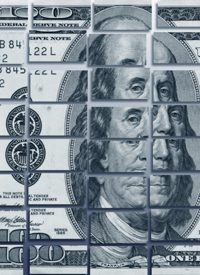
Daring to challenge the oft-repeated claim that any U.S. default would be a historic first, Wiggin points out that the United States has in fact defaulted several times in the past, such as when the federal government failed to redeem dollars for gold during the Civil War and the Great Depression. The latter default, when FDR took the United States off the gold standard rather than honor in full debts incurred during World War I and the Roaring Twenties, resulted in the U.S. dollar’s losing about 40 percent of its purchasing power. That default occurred in the context of a worldwide flight from the gold standard (technically, the gold-exchange standard in Europe; England and most of the rest of Europe had abandoned a full gold standard before the war, and never returned to it, substituting for circulating gold coinage the dubious promise to investors and foreign states to redeem currency in gold). And Wiggin might also have mentioned Nixon’s closing of the gold window — the final end to the U.S. gold standard — as a result of our inability to fully service debts incurred to fight the Vietnam War. That little parlor trick turned into roughly a dozen years of recession and stagflation, and is the real starting point of the bubble that led to the ongoing economic collapse.
We are now in the final stages of what economist Ludwig von Mises termed the “crack-up boom,” with the Fed (and other central banks abroad) printing money frantically to try to stave off the inevitable collapse and hyperinflation. We have been warning about this outcome for several years now, and it is indicative of how dire circumstances have become that the likes of Forbes magazine — not a purveyor of Austrian economics by a long shot — is now frankly acknowledging it.
As for specifics, Wiggins suggests that the U.S. debt situation may actually be worse than Greece’s, because our federal government is so artful at concealing and understating debt:
Greece’s debt-to-GDP ratio is 143%. America’s is officially 97%. But the $14.3 trillion national debt, stacked up against a $14.7 trillion economy, doesn’t tell the whole story. Look at these numbers:
• $14.3 trillion: “official” national debt
• $5 trillion: Amount Uncle Sam is on the hook for Fannie Mae and Freddie Mac
• $62 trillion: Total liabilities and unfunded obligations for Social Security and Medicare
That doesn’t count the black box of bailouts.
We know how much the Federal Reserve doled out in emergency loans: $16.1 trillion between December 1, 2007, and July 21, 2010. We know that because yesterday the Government Accountability Office completed its first-ever audit of the Fed, made possible largely through the persistence of Rep. Ron Paul (R-Texas) making that audit, however incomplete, the law.
What we don’t know is how much of that has been paid back. “We have literally injected about $5.3 trillion,” said Dr. Paul earlier this month during his questioning of Fed chief Ben Bernanke, “and I don't think we got very much for it. The national debt went up $5.1 trillion.”
Leaving aside the sheer wonder of Ron Paul given credence by Forbes, the figures are sobering if not alarming. We are obviously in debt tens of trillions more than the Federal government is willing to admit (after all, if those “unfunded liabilities” such as Social Security are not part of the debt, why is President Obama threatening not to issue Social Security checks without a higher debt ceiling?).
Consider: The amount under contention right now on Capitol Hill is $3 trillion in cuts — alongside a hike in the debt limit. Yet according to Boston University professor Laurence Kotlikoff, cited by Forbes, “The U.S. must cut spending or raise tax revenue by $20 trillion over the next decade, far more than either the president wants or the House Republicans seek.”
The hard reality is that America — both our government and our private sector — is hopelessly addicted to debt. Tens of millions of Americans are dependent on government healthcare, military pensions, government contracts, Social Security, government subsidies, government loans, and on and on. Making the sort of cuts Kotlikoff envisions would mean cutting or eliminating government subsidies and controls in education, housing, agriculture, banking, healthcare, entitlement programs, research grants, and on and on, as well as terminating our feckless warmongering overseas. But doing these things would send millions of students home from universities, force millions more homeowners into foreclosure, send home hundreds of thousands of military personnel and private contractors making money in Iraq and elsewhere, and allow free-market standards to once again hold sway in sectors — such as healthcare — that have been under government control for decades. All of these steps would entail restoration of liberty on a vast scale — a liberty millions of Americans, accustomed to the federal teat, no longer want. “I want the government to cut spending, but I expect to continue to get what’s due to me” — whether entitlements, welfare, subsidies, grants, or a government job — is the final appeal of a bankrupt nation.
All of the foregoing privations will come, of course, but probably not until the issue is forced by the laws of economics. Forbes estimates that the default will come in late 2012 or early 2013, and expects Washington to keep cutting deals and printing money as long as it can. It is a sad commentary on the state of our nation, and particularly our misnamed “political leadership,” that few of us are willing to accept the reality of what is happening. It’s nice that the scales are finally falling off eyes at Forbes, but it may be too little, too late.



